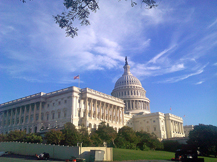Clean Energy Standard Act of 2012 Introduced
 The barrage of dirty energy bills being introduced in Congress is dizzying. With extreme policymakers looking to force the Keystone XL tar sands pipeline, cut funding for public transportation and dismantle EPA air quality regulations, the situation is bleak.
The barrage of dirty energy bills being introduced in Congress is dizzying. With extreme policymakers looking to force the Keystone XL tar sands pipeline, cut funding for public transportation and dismantle EPA air quality regulations, the situation is bleak.But there was some positive movement on clean energy in Congress today.
This morning, Senator Jeff Bingaman (D-NM) introduced a bill that would create a federal clean energy standard. His bill, the Clean Energy Standard Act of 2012, would increase the amount of low-carbon power produced in the United States to 80% by 2035, while providing the policy certainty that’s essential to growing the clean energy economy.
In introducing his bill, Bingaman was joined by fellow Senators Bernie Sanders (I-VT), Al Franken (D-MN), and Chris Coons (D-DE), each of whom praised the bill for providing a path forward on fighting climate change.
The Clean Energy Standard Act also has the support of the energy industry. In addition to usual suspects like the American Wind Energy Association and the United States Clean Heat and Power Association, GE Energy and NextEra Energy Resources are supporting Bingaman’s approach.
In previous work, the Center for American Progress has laid out criteria for what a successful clean energy standard would look like:
**It must generate new, long-lasting jobs and grow the economy
**It must effectively spur development and deployment of renewable energy and energy efficiency technologies
**It must account for regional diversity in resources and electricity markets
**It must be simple and transparent, and minimize costs
**It must provide a floor not a ceiling for clean energy, strengthening and building on existing state leadership
Bingaman’s CES proposal meets these criteria, and is the first serious proposal for a national clean energy standard that includes all low-carbon sources of power. The exact mechanics of his proposal rely on utilities holding “clean energy credits” for a certain percentage of their sales, maxing out at 80 percent in 2035.
Different generation resources are rewarded with a certain number of clean energy credits based on their carbon profile compared to an efficient coal-fired power plant. Instead of prescribing credits for different generating technologies, though, Bingaman’s bill calculates the credits based on individual power plant emissions, as reported to EPA. This creates an incentive for every power plant to be run more efficiently, especially natural gas plants.
There are several other innovative aspects to Bingaman’s proposal. For example, to make sure that this doesn’t inadvertently cause electric rates to increase, Bingaman allows utilities to buy an “alternative compliance payment” instead of holding clean energy credits. Instead of returning this money to utilities, he follows a CAP recommendation and returns the money to energy efficiency programs run by the states. This will lead to important energy efficiency investments.
Bingaman’s bill also recognizes that small utilities may initially have a hard time meeting the CES requirements. He addresses this by initially exempting utilities with fewer than two million megawatt-hours in annual sales, then gradually lowering the exemption level each year to bring more people into the program.
This proposal comes out of years of research and learning. Most recently, Senator Bingaman and Senator Lisa Murkowski (R-AK) requested input from a diverse set of stakeholders via a detailed questionnaire on different aspects of CES design. Incorporating this input has led to a policy that will get more renewable energy built, reduce carbon dioxide pollution, and make sure our economy continues to grow.
According to the Energy Information Administration, a well-designed CES proposal will reduce carbon dioxide emissions in the power sector by 43 percent. The EIA also found that US GDP growth would be virtually unchanged: without a CES, they expect GDP to grow at 2.69 percent per year, while they expect it to grow at 2.67 percent per year with a CES. Senator Bingaman has asked EIA to analyze his exact proposal, and we’ll likely see the results of that analysis in the coming weeks.
Despite the obvious strengths of this proposal, conventional wisdom says it’s going nowhere. Clean energy advocates should ignore that pessimistic outlook and urge the Senate to do the right thing and pass this bill.
You can return to the main Market News page, or press the Back button on your browser.

